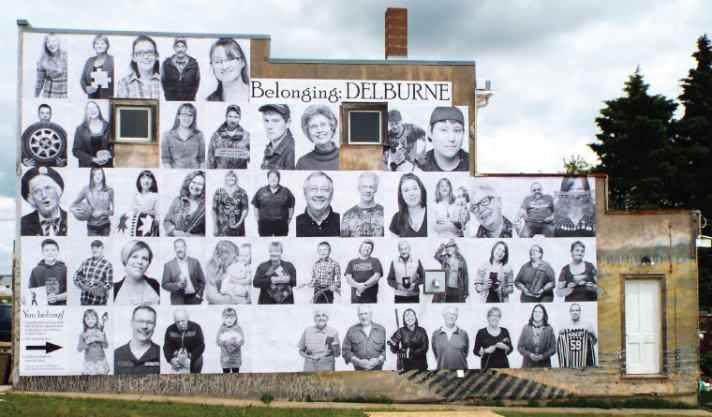We wanted to share a write up from Axiom News that featured a great initiative in Canada led by NCDD organizational member Tamarack. The lessons learned from this arts-based project to support community building are valuable for all of us, so we hope you’ll take a moment to read the Axiom piece below or find the original version here.
Massive, Main Street Photo Exhibit ‘Shifts Feelings’ in Alberta Community
 The Village of Delburne, located halfway between Calgary and Edmonton, Alberta provides a model for communities looking to engage residents in setting priorities and making decisions on what matters.
The Village of Delburne, located halfway between Calgary and Edmonton, Alberta provides a model for communities looking to engage residents in setting priorities and making decisions on what matters.
Earlier this year the village engaged in the “1,000 Conversations Across Canada” initiative championed by Tamarack, the Institute for Community Engagement.
The intent of the 1,000 Conversations campaign is to help shape communities by promoting the idea that citizens can collaborate and communicate with one another to create positive change.

Close to half the village population of about 830 representing a broad cross-section of the community participated in the conversations, a related survey, and an art project geared to strengthening the community’s sense of connection.
For the art project, internationally renowned portrait artist John Beebe collaborated with the village to create gigantic photos of local residents. These were then wheat-pasted on multiple exterior building surfaces throughout the village. The village school featured a collection of about 140 portraits.
Delburne Family and Community Support Services (FCSS) community worker Nora Smith has been a key champion of all of these efforts, but has been especially struck by the possibilities in art as a community-building tool.
“There’s something incredibly powerful in tying the art element into the community development piece,” says Nora. “I can’t really put my finger on it, but I know it’s there just by the way I watched the community members stop and appreciate each other.”
The art project is “shifting the feeling” in the community, which testifies to the foundational level of change that Nora and others are investigating through this community engagement process. The work is largely about the biases and prejudices that shape one’s thinking and therefore one’s way of being in society. “If we can start shifting people at that level, that would be fantastic,” Nora says.
Delburne residents have now identified and voted on the following four priorities for their community:
- Main Street revitalization
- Health and Wellness
- A Belonging Delburne project (which includes the art project)
- A communication project
- Plans are underway to re-engage in the Fall to flesh out tangible action plans within each of these four priorities. These plans will be revisited on a yearly basis to gauge accomplishments and reevaluate priorities.
Delburne represents a growing shift amongst communities and neighbourhoods in Canada to focus on stronger resident engagement, reducing the “role” of the local government in deciding what gets done and what doesn’t.
What other communities can learn from Delburne:
- Be strategic about engaging people. Paul Born’s book, Community Conversations, offers valuable insights on how to ensure everyone who should be at the table is there.
- People inviting those they have a relationship with to participate in the community engagement process is critical to ensuring strong engagement.
- Trust the process. “It’s so easy as someone working in community development to want to give the answers,” Nora says. “Have faith that the answers are eventually going to come out of the community itself.” It’s important that the answers do emerge this way, to ensure sustainability as residents “own” the actualization of these answers.
- Strengthening community engagement is a process: it takes time and work.
- Strongly consider integrating the art element into community development efforts.
This story is part eight of a series focused on placemaking and other citizen led initiatives. To read the other entries in this series, visit the original post here.
You can find the original version of this Axiom News piece at www.axiomnews.com/massive-main-street-photo-exhibit-%E2%80%98shifts-feelings%E2%80%99-alberta-community.


